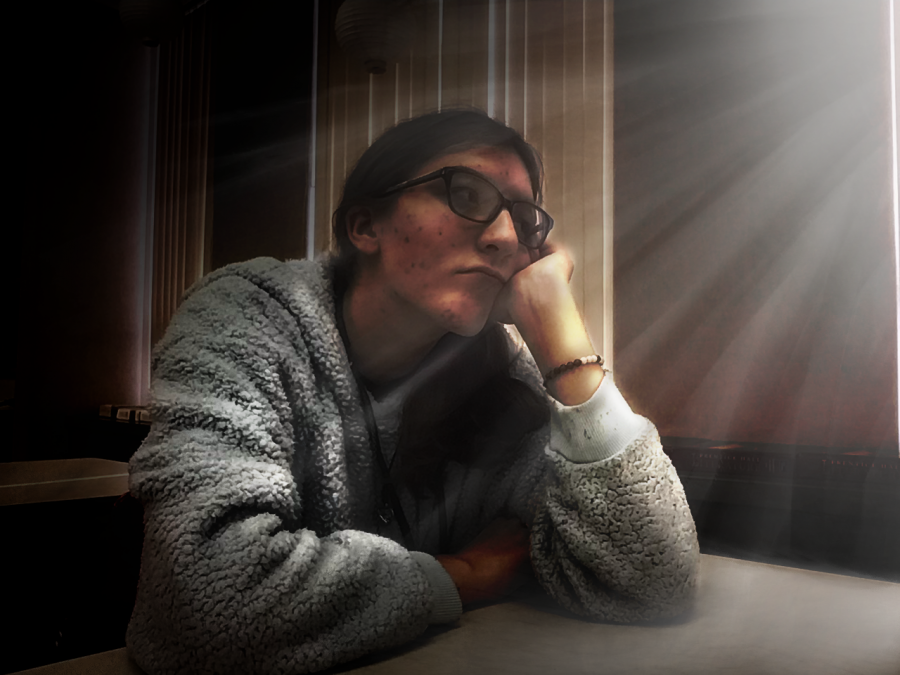Tired And Burned-Out With The Coming Cold?
November 12, 2021
Tired and burned-out with the coming cold? Here are some ways to help.
As October turns to November, fall turns to winter, and the temperatures drops more frequently past the line where one can reasonably wear just a light jacket or hoodie, several may notice that they’re starting to feel even more tired and sluggish in the morning, more exhausted throughout the day, and less willing to work on their assignments for school.
Some may be feeling this way much more intensely than others. And, to all those who are dealing with these strange feelings, it’s highly possible that they may be dealing with some type of seasonal depression, or some type of burnout. This may sound scary, but explained, it may seem like much less of a beast than it was at first.
Seasonal affective disorder is a specific type of depression–meaning that there are those who do directly deal with this problem, and that not everyone suffers from this depression type. However, if overhearing someone talking about seasonal depression in a very general sense, realize that while it is technically very common—with more than 3 million suffering from it per year in the U.S. alone—not everyone actually suffers from this disorder, but, there are those who may react in the same manner as those who are actually diagnosed with SAD when both are interacting with the similar stimuli. So whether or not one is diagnosed with or definitively suffers from SAD, this issue can easily affect everyone.
Burnout is something that is frequently dealt with by those who may have mental illness or disorders, especially those who are neurodivergent, but anyone can experience it, and different forms of it. As Help Guide states, “burnout is a state of emotional, physical, and mental exhaustion caused by excessive and prolonged stress.” College-searching, test- and quiz-taking, sports, practicing for driver’s education and or driving tests, jobs or job-searching–it’s fairly easy for any average high school student to deal with this at some point or another. Combined with diagnosed SAD—or a general influence of some sort that acts like SAD—this upcoming winter can easily be a struggle for anyone with all of these responsibilities and issues piled on top of them.
Is there any way to cure these two ailments?
Unfortunately, no. But, there is extensive information and research out there on how best to help one’s self deal with both of these issues!
With SAD, very frequently medication is the solution that works best for all sorts of people and is most frequently used to help deal with it. Considering that SAD is actually a type of depression, antidepressants are one of the most effective treatments against it. However, this is not the only avenue that those with SAD, or something akin to it, have to go down to help themselves; in fact, therapy and self-care are well-known to improve symptoms. Physical exercise, while not only improving one’s health, has been known to boost “serotonin, endorphins, and other feel-good brain chemicals,” as Help Guide states. “In fact, exercise can treat mild to moderate depression as effectively as antidepressant medication.”
Of course, not everyone may feel better just by moving around for roughly 20-30 minutes every day, but that’s where therapy can help. While there are all sorts of therapies that can help improve how one feels, one that, at the very least, helps somewhat, and at the very most, is incredibly effective, is light therapy. Having a device called a light box, or something similar to it, can “mimic” natural sunlight, causing one’s body to believe it is being subjected to more sunlight than it was previously. This treatment has been proven to greatly improve how one feels, improve one’s mood, and one’s attitude.
With burnout, there isn’t a very simple solution that comes with dealing with it, especially as it can happen and affect one’s self at any time or moment and isn’t limited to seasons. A very effective way to deal with burnout is to turn to others. Reach out to those closest, be more social with peers and classmates, limit contact with negative or toxic people, possibly even try connecting to a cause or a local community group that is personally meaningful. Finding new friends can help greatly, and what’s better is—as Help Guide states—“being helpful to others delivers immense pleasure and can help to significantly reduce stress as well as broaden your social circle.”
Another way to help one’s self is to reevaluate your priorities: Set boundaries, take breaks from technology—as well as people, for those more introverted or just generally exhausted by spending way too much time around others—do things that stimulate the creative side, get plenty of sleep, and set aside some personal time to relax and recover. If people don’t take breaks, especially frequently, it may lead to them feeling strained and stretched out beyond their limits, causing them to start to suffer from stress and or burnout. Learning how to limit oneself–such as cutting off how much time is spent on technology or around others and learning how to be able to say “no” and “yes” to others–prevents one’s self from feeling so strained and from developing the feelings of burnout.
Just as with SAD, exercise is highly endorsed, especially rhythmic exercise where both arms and legs get the most amount of movement in, since, in Help Guide’s words, it is “a hugely effective way to lift your mood, increase energy, sharpen focus, and relax both the mind and body.” Help Guide also suggests trying walking, running, weight training, swimming, martial arts, or also dancing–all as ways to participate in some rhythmic exercise. The website does, as well, state something incredibly helpful that those especially who deal with anxiety and panic/anxiety attacks may recognize as being akin to grounding and calming techniques: “To maximize stress relief, instead of continuing to focus on your thoughts, focus on your body and how it feels as you move: the sensation of your feet hitting the ground, for example, or the wind on your skin.”
However, a bit separately from dealing with SAD, but in the same vein as exercising, people’s mood can be severely affected by just their diet, what nutrients they are getting (through food or other sources), and how frequently they are eating in a day or a certain time frame. “Minimize sugar and refined carbs[:] You may crave sugary snacks or comfort foods such as pasta or French fries,” starts Help Guide on this topic, “but these high-carbohydrate foods quickly lead to a crash in mood and energy.” The site continues on to describe how ingesting large amounts of specific foods, nutrients, and specific chemicals can have an adverse effect on one’s mood, with such culprits being caffeine, unhealthy fats, and foods with chemical preservatives or hormones. “Eat more Omega-3 fatty acids to give your mood a boost,” also states Help Guide. “The best sources [of these nutrients] are fatty fish (salmon, herring, mackerel, anchovies, sardines), seaweed, flaxseed, and walnuts.” The site concludes its coverage on burnout treatment strategies on something that may be viewed as a “no-brainer” to most: Avoid nicotine, and if one is to drink alcohol, drink it in moderation. However, no one under the legal age should be considering these anyway, as the negative effects worsen on developing bodies.
In a world where society wants everyone to work a lot harder, for a lot longer, from times spanning from sunrise to the dead of night, constantly, average rates for SAD and especially for burnout will very highly likely rise to harsh, numerous degrees of unknown, catastrophic proportions. While things really shouldn’t be this way, not much can be done to immediately change this way of thinking and working that has existed for decades now—until such changes are made, it is, at the very least, incredibly useful to know ways to help one’s self or others when dealing with issues of these sorts. It’s not perfect, and likely not every possible treatment method, or solution, listed or mentioned previously, may work for every single person—however, there is bound to be something that can be proven useful for sufferers of these conditions.
And, who knows? Maybe in just a few years, work and society may have better ties to each other, and no longer harm those who actively work. Maybe a newfound treatment method will be the shining Holy Grail for those who deal with this. Maybe, just maybe, in a few years’ time, there will be a discovered and developed 100% cure for these kinds of problems. Honestly, who’s to say?








